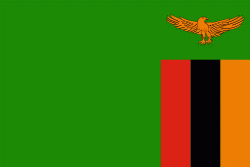Mporokoso
Mporokoso (also spelled and pronounced 'Mpolokoso' and 'Mumpolokoso') is a town in the Northern Province of Zambia, lying at an elevation of nearly 1500 m on the flat plateau about 75 km south east of Lake Mweru Wantipa and 100 km south-west of Lake Tanganyika. It is named for Chief Mporokoso (also spelled 'Mumpolokoso') a senior chief of the Bemba people whose palace is located at Chishamwamba close to the town. Mporokoso District is also one of the 12 administrative districts of the Northern Province.
A large population of refugees from the Second Congo War living at the UNHCR-administered refugee camp at Mwange, 32 km west of the town, are being repatriated after the end of that war.
A number of waterfalls lie within 50 km of the town. The closest is the Kapumo Falls, 7km south-west of the town centre. Pule Falls and Mumbuluma Falls III are on the Luangwa River (not to be confused with the river of that name in eastern Zambia) which flows to the south of the town. Lupupa Falls are on the nearby Mukubwe River.
A large population of refugees from the Second Congo War living at the UNHCR-administered refugee camp at Mwange, 32 km west of the town, are being repatriated after the end of that war.
A number of waterfalls lie within 50 km of the town. The closest is the Kapumo Falls, 7km south-west of the town centre. Pule Falls and Mumbuluma Falls III are on the Luangwa River (not to be confused with the river of that name in eastern Zambia) which flows to the south of the town. Lupupa Falls are on the nearby Mukubwe River.
Map - Mporokoso
Map
Country - Zambia
 |
 |
| Flag of Zambia | |
The region was affected by the Bantu expansion of the 13th century. Following the arrival of European explorers in the 18th century, the British colonised the region into the British protectorates of Barotseland-North-Western Rhodesia and North-Eastern Rhodesia comprising 73 tribes, towards the end of the 19th century. These were merged in 1911 to form Northern Rhodesia. For most of the colonial period, Zambia was governed by an administration appointed from London with the advice of the British South Africa Company. On 24 October 1964, Zambia became independent of the United Kingdom and prime minister Kenneth Kaunda became the inaugural president. From 1972 to 1991 Zambia was a one-party state with the United National Independence Party as the sole legal political party under the motto "One Zambia, One Nation" coined by Kaunda. Kaunda was succeeded by Frederick Chiluba of the social-democratic Movement for Multi-Party Democracy in 1991, beginning a period of government decentralisation.
Currency / Language
| ISO | Currency | Symbol | Significant figures |
|---|---|---|---|
| ZMW | Zambian kwacha | ZK | 2 |
| ISO | Language |
|---|---|
| NY | Chichewa language |
| EN | English language |















